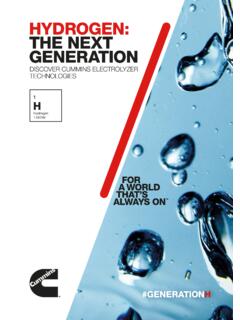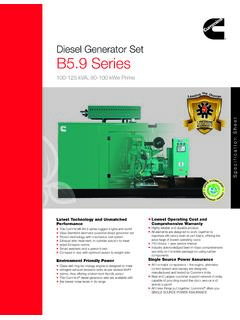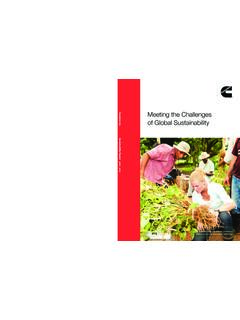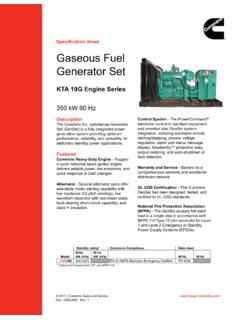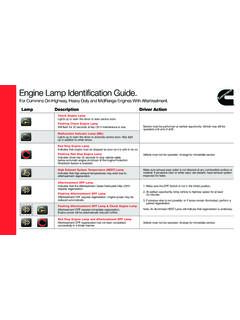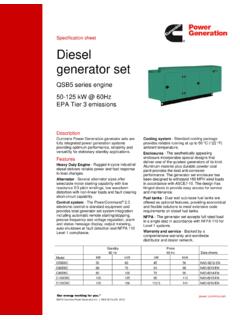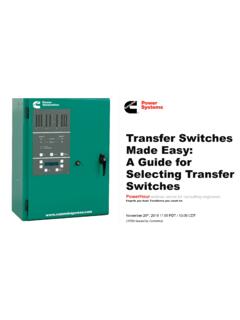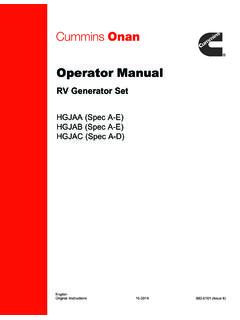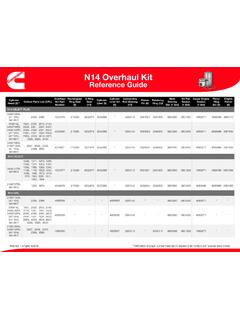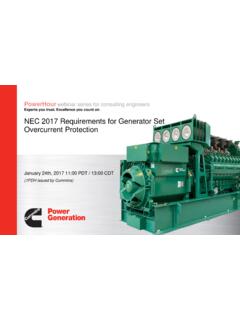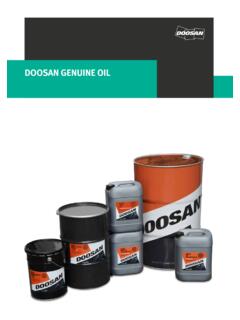Transcription of PowerHour Emissions Air Permitting - Cummins
1 June 25, 2019 11:00 PDT / 13:00 CDT(1 PDH issued by Cummins ) Emissions and Air Permitting Requirements for Standby Generator SetsPowerHourwebinar series for consulting engineersExperts you trust. Excellence you count ! PowerHour is designed to help our engineer partners Keep up to date on products, technology , and codes and standards development Interact with Cummins experts and gain access to ongoing technical support Participate at your convenience, live or on-demand Earn Professional Development Hours (PDH)Technical tips.
2 Audio is available through teleconference, or your computer (don t forget to unmute) You are in listen only mode throughout the event Use the WebEx Q&A Panelto submit questions, comments, and feedback throughout the event. We will provide sufficient Q&A time after presentation If you lose audio, get disconnected, or experience a poor connection, please disconnect and reconnect Report technical issues using the WebEx Q&A Panel, or email local Cummins contacts: Western Canada: Ian Lindquist Western Canada Region Eastern Canada: Gianluca Ianiro Eastern Canada Region AZ, ID, NM, NV: Carl Knapp Rocky Mountain Region CO, MT, ND, UT, WY: Chris Scott Rocky Mountain Region Northern IL, IA.
3 John Kilinskis Central Region UP of MI, MN, East ND, WI: Michael Munson Central Region NE, SD, West MO, KS: Earnest Glaser Central Region South IL, East MO: Jeff Yates Central Region TX, OK, AR, LA, MS, AL, Western TN: Scott Thomas Gulf Region FL, GA, NC, SC, Eastern TN: Robert Kelly South Region NY, NJ, CT, PA, MD: Charles Attisani East Region CA, HI: Brian E Pumphrey Pacific Region WA, OR, AK: Tom Tomlinson Pacific Region For other states and territories, visit your panelistsMichael SanfordTechnical Marketing SpecialistCummins presenter: Cummins facilitator:Tom Bakritzes, Global Sales Training ManagerCummins Resolution Headshot4 DisclaimerThe views and opinions expressed in this course shall not be considered the official position of any regulatory organization and shall not be considered to be, nor be relied upon as, a Formal Interpretation.
4 Participants are encouraged to refer to the entire text of all referenced documents. In addition, when it doubt, reach out to the Authority Having ObjectivesEmissions and Air Permitting Requirements for Standby Generator SetsAir Permitting for standby generator sets can vary wildly from site to site and when misunderstood can have a major impact on project success. Although EPA regulations have stabilized and are thought to be well understood, ever-increasing local requirements are changing the criticality of air Permitting for engine-driven generator sets.
5 This course will provide a brief overview of regulated Emissions constituents and their formation in order to provide a foundational understanding of engine Emissions . Next, the EPA's New Source Performance Standards (NSPS) will be reviewed as it relates to both compression ignited (diesel) and spark ignited (natural gas or propane) engine equipped generator sets. Participants will gain an awareness of common pitfalls related to Emissions Permitting and will be introduced to various strategies employed to meet local Emissions completing this course, participants will be able to: Recognize commonly regulated exhaust Emissions constituents.
6 Describe EPA Emissions requirements for diesel and gaseous standby generator sets. Identify common requirements for Permitting engine-driven generator are some of the commonly regulated exhaust constituents?7 Exhaust Emissions FormationCxHYSZO2+N2 FuelAir8 Exhaust Emissions FormationCxHYSZO2+N2 FuelAirCO2+H2O+O2+N2 Major Exhaust Constituents9 Exhaust Emissions FormationCxHYSZO2+N2 FuelAirCO2+H2O+O2+N2 Major Exhaust ConstituentsNOx+HC+CO+SOx+CTrace Exhaust Components10 Exhaust Emissions FormationWhat is it?How is itformed?CISINOxOxides of nitrogen (NO and NO2)Formsat high in-cylinder temperatures, most prominent during high engine load.
7 HCOver 100 different typesof hydrocarbonsProduct of incomplete combustion, most prominent during lowengine load. NMHCNon-methane hydrocarbons, subset of total hydrocarbonsProduct of incomplete combustion, dependent on fuel composition. VOCV olatile organic compoundsPrimarily hydrocarbons but may include other compounds. PMAnythingthat is trapped on or condenses onto a filterMost prominent during low load operation. COCarbon monoxideProduct of imperfect combustion, most prominent during lowengine load. SOxOxidesof sulfur(SO and SO2)Productof combustion process when sulfur is present.
8 Increases linearly with fuel consumption. 11 New Source Performance Standards (NSPS) for Compression-Ignited and Spark-Ignited engines12 What is NSPS?New Source Performance Standards13 What is NSPS?New Source Performance Standards14 What is NSPS?New Source Performance StandardsSource of Emissions , when manufactured or installed15 What is NSPS?New Source Performance Standards16 What is NSPS?New Source Performance StandardsEmissions limits, operational guidelines and test methodologies17 What is NSPS?New Source Performance StandardsEmissions limits, operational guidelines and test methodologiesSource of Emissions , when manufactured or installed18 Requirements for EPA Certified Engines Engines are certified, not generator for EPA Certified Engines Engines are certified, not generator sets.
9 Engines are required to meet Emissions levels based on their date of manufacture, usage and brake horsepower for EPA Certified Engines Engines are certified, not generator sets. Engines are required to meet Emissions levels based on their date of manufacture, usage and brake horsepower rating. Emissions levels are evaluated on a standardized test cycle including engine load and pollutant weighting following a specific test method in a test-cell for EPA Certified Engines Engines are certified, not generator sets. Engines are required to meet Emissions levels based on their date of manufacture, usage and brake horsepower rating.
10 Emissions levels are evaluated on a standardized test cycle including engine load and pollutant weighting following a specific test method in a test-cell environment. Engines and Emissions control devices must be certified as a complete solution by the engine manufacture (field upfit or third-party installations cannot meet certification requirements).22 EPA Engine Usage DesignationsStationaryEmergencyNon-Emerg encyNonroadMost StringentLeast Stringent23 Stationary and Nonroad EnginesStationary On site for at least 12 consecutive months.
